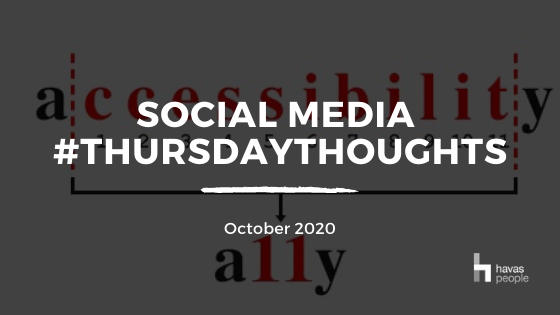What’s the A11Y Accessibility Project, and why you should care

by SIOBHAN MULCAHY & VALERIA PERILLI | Published on October 1, 2020
Welcome to our third #ThursdayThoughts social media blog, where we discuss the latest trends and cultural events that are taking over the social media industry and creating new opportunities for hundreds of companies in the employer brand space. This month, we’ll be focusing on the impact of the A11Y project.
First things first, what is the A11Y Project? A11Y stands for accessibility, the project is a community-driven effort to make the digital space easily accessible to audiences with disabilities.
Why is accessibility important in the digital space? Well, imagine living in a world where your capacity to create and consume content is diminished. “For many, technology built with accessibility in mind makes things easier. For people with disabilities, technology makes things possible.”
An estimated 1 Billion people live with disabilities, that is around 15% of the world’s population. As the world’s largest minority group, these are the people who are affected by the decisions we make.
Most companies praise themselves on creating an inclusive culture for their employees – but are they striving to be inclusive towards their online audiences, and prospective candidates? On Instagram, you’ll rarely see A11Y accessibility captions (like in these Cisco’s post examples), and although they’re very easy to create and introduce within social copy, they provide an alternative way to perceive an image for those who are unable to see it or interpret it on their own.
Here are some top tips to make your social media content more accessible:
- Add alternative text and image descriptions to posts. Alternative text should be kept short (125 characters), so image descriptions are helpful to add more information.
- Write hashtags using PascalCase. This is required so that screen readers can identify where a word starts and ends. Only write in all caps when using an acronym as some screen readers will read posts in all caps one letter at a time.
- Including captions on videos and embedded transcript. Captions benefit people who have hearing impairments while auto captioning videos provides a benefit to those using a screen reader. Instagram has just released IGTV auto-captioning in 16 languages.
- Choice of colours on images and captions. Ensure there is a clear colour contrast between copy and background.
- Consider your font choice. Avoid styled fonts as screen reader are unable to read decorative fonts as text. Sans Serif and Arial are commonly used fonts for people who are dyslexic or visually impaired.
- Limit emoji use and ensure they are relevant. A screen reader will read out emojis i.e. 😎 “smiling face with glasses” so ensure your call to action is placed before the emojis and the copy is limited to no more than three emojis per message.
The A11Y project spans across the whole digital landscape – from websites to social media.
You can become an advocate for inclusive social media by taking a proactive approach. So, the next time you write a social post, just think that you have the power to make a difference at your fingertips.
